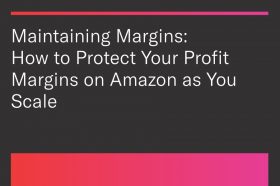Resources - Blog
Maintaining Margins: How to Protect Your Profit Margins on Amazon as You Scale [Webinar Recap]

In order to look at your Amazon business holistically, you cannot define profitability by one freestanding variable, but by many variables together. In an ideal world, all parts of your business should be monitored regularly to maximize their value. Having targets in place that focus on variables that you are optimizing will be crucial to making sure that one facet of your business isn’t entirely ignored or undervalued. From there, you can uncover strategies to preserve and increase your profit margins on the Amazon marketplace. In our latest Ask the Amazon Experts webinar, Feedvisor’s team was joined by Zane Gamboa from ShipStation to explain the importance of logistics, automation, and optimizations to help you focus on profit-generating activities. Andrew McGonnigle from Feedvisor focused on actionable ways that you can effectively manage fees and returns and simultaneously optimize your pricing strategy to maintain your margins while you scale.
Amazon’s Partnered Carrier Program allows you to reduce the costs of shipping to Amazon by up to 45%
Logistics and Automation
Implementing a robust logistics and automation process for your Amazon operation will help optimize your shipping process, eliminate errors, reduce costs, fulfill promises to customers, and build your brand ethos and experience. Below are a few ways that you can fine-tune your logistics processes:
1. Establishing a Thorough Scanning Workflow
When incorporating both scan to print and scan to view options into your scan workflow, you will be able to instantly get each package’s weight, the carrier rate, and shipping label at your fingertips and simultaneously pull up order details from a packing slip barcode to view easily, even on mobile. These features make your workflow more efficient, without having to worry about keyboard commands. Performing common functions by barcode will help decrease avoidable mistakes within the logistics workflow.
2. Automating Everything
To maximize productivity, there are several ways you can customize your workflow to make sure there are no overlapping responsibilities and your time is being allocated properly.
- Service mapping is when an order is inputted with a specific service requested and you can assign that particular service and a specific package type based on that request. For example, when a customer selects ground shipping such as UPS Ground, the preferred package type will meet the criteria upon import and won’t need to be applied manually.
- Automation rules can help you automatically manage orders and reduce the time it takes to create labels. They are account-specific and user-created rules that tell specific software to automatically perform certain actions on orders based on specific criteria. This allows you to take care of orders in which service mapping doesn’t really apply.
- Tagging allows you to identify orders based on specific tags and can indicate special situations for your shipping crew. You can also sort, filter, and order your tags, view orders containing specific tags, and utilize the tags to help your employees bulk process more orders.
3. Optimizing Your Customer Touchpoints
Appealing to the customer’s intent and making the end-to-end shopping experience as seamless as possible for them is critical to e-commerce success. For a custom brand experience, you can customize your packing slips to include exclusive offers, show off your brand, and drive traffic back to your Amazon store. For example, you can include a special packing slip that says they will get a special deal on their next order if they spend $150 or more. Next, having a customer-initiated returns portal can also help aid the branded experience and offer a customer friendly approach for returns management. For these user-generated returns, software is available to auto-generate return merchandise authorization and email labels to customers directly. You can report on exactly why things are being returns and analyze the issues so you can cut down on future returns and maintain your margins more effectively. Another suggestion that ShipStation provided was utilizing a branded e-commerce label, which is a five-panel pull-out label that offers unique branded experiences, tells customers about your brand story, and increases customer engagement. The label can offer discounts and cross-sell opportunities such as a percentage off the next order and provides a comprehensive brand experience for your customers. Regardless of your fulfillment channel, returns can cut into your profit margins significantly if they aren’t managed properly. When analyzing items to potentially add to your assortment, do so carefully to make sure the items will be accurately represented and true to any sample that you have received from the supplier. Next, establishing Terms of Trade with your supplier will help you negotiate for different types of discounts. Beyond regular “off the price list” discounts, they may also offer growth rebates, shipping discounts, free shipping, or even lower bulk prices on their products. With returns, however, the Terms of Trade will come into play with damaged and defective goods. If the items were damaged in transit, you need to take up the issue with your shipping company. If it was damaged in the warehouse, you need to take it up with Amazon. However, if the product is defective, you should raise the issue with your supplier, as you are not responsible for defects.
Stay on top of the latest e-commerce and marketplace trends.
Understanding and Leveraging Fees
In this webinar, we focused on shipping, referral, and storage fees that you need to navigate as an Amazon seller. It is important to note that these fees vary quite drastically depending on several variables, such as your fulfillment method, product categories, and industry relationships.
1. Shipping Fees
With Amazon FBA, since they are sending out your order, you also pay picking and packing prep charges for things like labeling, bubble wrapping, and labor. With Fulfillment by Merchant or Seller Fulfilled Prime, be sure to research prep costs, as these can sometimes be more affordable if taken care of via your own warehouse. No matter how your items are fulfilled, proper prep and packing will only make adding them to inventory much faster. For low-value items or items with a selling price that is below $20, saving on prep charges can add up to two percent to your total profits. If you are looking to save on shipping you should strongly consider Amazon’s Partnered Carrier Program. It allows you to reduce the costs of shipping to Amazon by up to 45%. Sometimes, you may choose not to use it because you have a stronger shipping contract in place or want to expedite a shipment using your own partner carrier. This program allows you to make domestic shipments to Amazon at significantly lower rates. For logistics partner shipping, leverage your relationships with FedEx, UPS, and the USPS and constantly revisit them to ensure that you are capturing more value for yourself as you use their services more and your business continues to grow. Although annual negotiations require time and intensive research, they can be extremely impactful. For shipping and handling, you should use your supplier to ship products directly to Amazon or the customers if the cost makes sense. For supplier handling and prep, many suppliers charge a handling or dropship fee. However, this is negotiable and can sometimes be completely waived if you are willing to inquire about it. Prep for FBA can also be done by the supplier, but it is your responsibility as the seller to drive that conversation. In the long run, it can end up saving time and money to get everything completed at the supplier level.
2. Referral Fees
As you know, there is a 6-45% referral fee for each item that you sell on Amazon. However, many sellers are unaware that Amazon offers periodic promotions where you can receive referral fee discounts that are either price related, selection related, or Prime related. For price-related referral fee discounts, some products may be eligible for a referral fee discount when sold below a certain price threshold. You will receive the listed referral fee discount and continue to receive it on any and all items sold at or below the threshold price until the discount period concludes. Amazon also occasionally offers referral fee discounts on products that are in demand or new in a certain category. There is no price limitation on these products and, like above, eligibility applies until the discount period concludes. Lastly, there are occasional, limited-time referral fee discounts on items sold through FBA or Seller Fulfilled Prime and these also have no pricing limitations. In order to optimize your referral fees, you should make sure that your product categorization for every ASIN is correct or run the risk of overpaying these fees.
3. Storage Fees
Especially as your business enters the next level of scale, regular inventory management and optimization will be critical to monitoring your storage fees. To ensure that you don’t overpay, you should understand how these fees are calculated and pay attention to the cost of your capital. If, for example, you have inventory worth $350K in an Amazon FBA fulfillment center, that is working capital which can compromise your margins if it becomes stagnant. The more you invest, the more your business costs to run if it is not optimized properly. From a product assortment point of view, if you are changing your strategy then you will also need to review your storage fees and assess the impact of the change. Additionally, you should look at which products are absorbing most of the storage fees and think about if it makes sense to move on from them — they are cutting into your profit margins when they aren’t moving off the shelves.
Pricing: Past, Present, and Future
Accurate, dynamic pricing and a specific, SKU-by-SKU pricing strategy will help you fully maximize your product potential. You should look back at your historical data and see what variables shaped your sales trends. Did you have steady profits across your assortment and did you experience growth over time? Were you operating by the 80/20 rule? What items are cutting into your profit margins and what can be revisited on those items to optimize for the future? When considering adding new items to your catalog, be sure to understand how they will fit into your overall pricing strategy. Upon reviewing your total assortment, assess whether your expected profit margins align with reality. If not, adjust your pricing immediately and consider how these adjustments will impact your long-term pricing strategy.
Learn what Feedvisor can do for your business.
When you partner with Feedvisor, you automatically receive access to our true, AI-driven technology and hands-on team of e-commerce experts. Contact one of our team members today to learn more about our end-to-end solution for brands and large sellers on Amazon, Walmart, and e-marketplaces.

![5 Avoidable Mistakes Hurting Your Gross Profit Margin on Amazon [Guide]](https://feedvisor.com/wp-content/uploads/2018/08/blog-5-avoidable-mistakes-hurting-your-gross-profit-margin-on-amazon-280x186.jpg)

